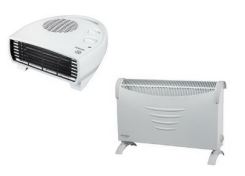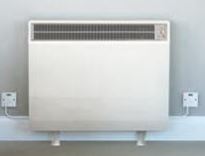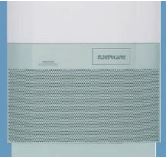Direct acting heaters
Convector / fan heaters
 |
Advantages
- Low cost to install
- Free standing or wall-mounted versions
- Thermostat to control heating level
- Different power settings
- Different models, designs and styles
|
Disadvantages
- Use dearer ‘day time’ electricity
- Take a while to warm up the room
- Ineffective in large/draughty spaces
|
Other things to consider
- Check that heaters are not left on after closing
- Use timer to control heating times
|
Radiant heaters
 |
Advantages
- Low cost to install
- Instant heating
- Provide local warmth outdoors or in large/ draughty locations
- Different makes, models and styles
|
Disadvantages
- Use dearer ‘day time’ electricity
- No thermostat control so uses full power when switched on
- Fire risk if not positioned correctly
|
Other things to consider
- Use ‘people sensors’ or timers to control heating times
|
Storage Heating
Standard storage heater
 |
Advantages
- Take charge overnight using low cost ‘night time’ electricity
- Set input to control high in winter/ lower in milder weather
- Robust, long lasting and reliable– rarely need serviced
- Different models, makes and designs
|
Disadvantages
- More expensive than convectors to install
- Need special wiring (can’t be plugged into socket)
- Harder to control the heating comfort level
- Have to set charge level the night before
- Very hot to the touch -safety issues with small children and the elderly
|
Other things to consider
- Consider installing a Pactrol ‘weather watcher’ to automatically regulate the overnight charge. An electrician can advise you on the cost of fitting this.
|
Fan assisted storage heater / Electricaire

|
Advantages
- Similar to storage heater but with better temperature control
- Heat output controlled by a fan & thermostat
- Cooler to the touch than storage heaters
- Electricaire is the upright cabinet sized version
|
Disadvantages
- More expensive to install– but running costs are typically 30% less than storage heaters
- Fan can be noisy in older models
- Slightly bulkier than storage heaters
|
Other things to consider
- Use a timer to control heating times and thermostat to control room temperature
|
All images kindly supplied by Dimplex
A quick guide to Nightsaver tariff (formerly called Economy 7)
Nightsaver tariff provides 7 hours of cheap ‘night time’ electricity between 1am and 8am (2am to 9am in summertime). You can use the low-cost electricity to provide hot water and heating the next day. You can also use this tariff to make savings on any appliances that are running through the night, for example fridges and freezers.
Storage heaters
- Storage heaters use only low rate electricity
- They store up heat at night in a special type of brick and slowly release it the following day
Storage heater controls
Make sure the wall switch is in the ‘on’ position before using your heater. Storage heaters have two controls:
Input
- Input allows you to select the amount of heat stored overnight
- Use a high setting in winter and a lower setting in milder weather
Output (or boost)
- This controls a little flap inside the heater, allowing the heat to escape more/less quickly
- A high setting will open the flap automatically in the afternoon while a lower setting will open it later in the evening
Storage heater safety
- Never cover storage heaters with curtains, clothing or push furniture too close. These are serious fire risks.
- If a single heater suddenly stops working the ‘thermal cut-out’ may have operated. This is a safety device to indicate that the heater has overheated (usually because of clothing/furniture being too close). Your electrician can easily re-set this for you.
- If all of the heaters suddenly stop working it may be a problem with the NIE Networks teleswitch or your fuse box/consumer unit.
Energy saving tips
Temperature control
Once the storage heater has taken a charge overnight, there is little you can do to adjust the heat coming out the next day. The ‘output’ or ‘boost’ control will help slightly, but the secret to good temperature control is to vary the input to suit the forecasted weather conditions for the next day.
Hot water
Economy 7 will provide a full cylinder of hot water each morning and, depending on the wiring, a one hour ‘top up’ in the afternoon. Economy 7 water heating is usually controlled by your own time switch or by an NIE Networks teleswitch.
Further information
For our full range of Customer Guides and FAQs, visit our Help & Support section at www.powerni.co.uk/business/help-support

